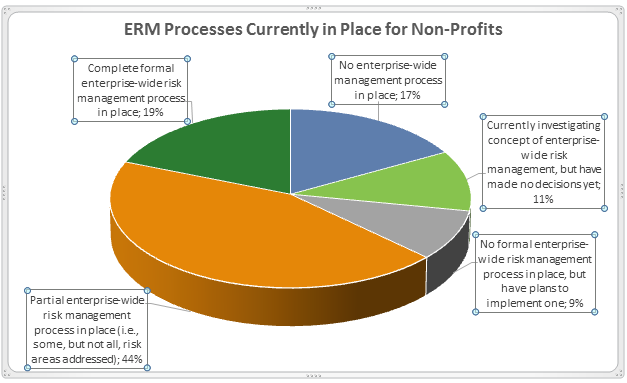There are so many news articles about how for-profit companies are tackling issues that they experience and advice for how to anticipate potential issues. But what about the non-profit organizations? They are driven by a different purpose, often have a social aspect that involves people, and yet, they are just as, if not more, vulnerable to risks and opportunities.
The Enterprise Risk Management (ERM) Initiative at North Carolina State University, in partnership with the American Institute of Certified Public Accountants (AICPA), just released their 8th State of Risk Oversight report, which provides an overview of ERM practices for a variety of industries. Non-profit organizations make up 25% of the total 432 respondents of the survey, so there is a significant amount of data to analyze for this sector and leads me to some ideas. This article is focusing on the opportunities and benefits that exist for non-profit organizations when it comes to ERM.
- Risk Volume and Complexity: Non-profits indicated that the overall business environment in which they operate is relatively risky, with approximately 55% of non-profits saying that their risks have “mostly” or “extensively” increased in the past 5 years.
- Operational Surprises: Risks can and do occur, but it’s never good when the organization is surprised. Unfortunately, about 67% of non-profits “mostly,” “somewhat,” or “extensively” experienced operational surprises in the last 5 years. With the complexity of risks increasing, organizations are getting hit with more unexpected operational issues. “The reality…suggests that opportunities to improve risk management techniques still exist for most organizations.”
ERM is different than your typical risk management, as this article explains, and can provide many benefits to the organization. But it takes a commitment from leadership, among other things, to make it successful.
- Maturity of ERM Processes: Twenty-eight percent (28%) of non-profits have no ERM processes in place today, with only 11% of those organizations investigating concepts of ERM but with no decision made yet. In fact, less than 20% of responding non-profit organizations have complete ERM processes in place. But when identifying the level of maturity of those processes, a whopping 36% have “very immature” or “developing” ERM.
Let’s pause and think on these three areas – risk volume and complexity, operational surprises, and maturity of non-profit ERM process – because they are definitely connected.
If the environment in which your organization operates has gotten more complicated, isn’t it more important to be proactive in identifying threats and opportunities that can support your organization achieving its mission?
After all, a non-profit cannot achieve its mission without donors, and a majority of donors are larger companies who will be familiar with ERM. So they will do their due diligence and ask about any ERM activities at the non-profit.
Don’t get me wrong – great progress has been made in the last few years. The 2014 version of this report showed that 24% of non-profits had partial ERM in place, so an increase of 20% over 3 years is pretty decent. Mature ERM won’t happen overnight; in fact, it typically takes several years to get there.
So don’t be discouraged if you thought it would be done in 1-2 years. Stay the course, but don’t be afraid to adapt the program to changes in the organization, leadership, or external influences.
Now about those benefits of ERM…
The best way to show the value of having an ERM program is to link the idea with strategy. Help leadership achieve the mission and objectives of the organization. This help can take the form of:
- Facilitating the identification of roadblock(s)s to achieving the objectives and discussions on how to remove or minimize the roadblock(s);
- Identifying opportunities that exist to meet or exceed the objectives;
- Working with leadership during the strategic planning efforts to ensure the objectives themselves are mindful of potential threats and opportunities.
ERM can provide other benefits to non-profits, as identified in this article by Grant Thornton.
What are your thoughts on the state of ERM within the non-profit sector?
Please share your thoughts in the comment field below, or join the conversation on LinkedIn.
Do you want to help your non-profit thrive but need to know more about ERM? Are you struggling to get your risk management initiative off the ground or back on track?
I can help your non-profit reap the benefits of enterprise risk management to better achieve your mission and goals! Contact me to discuss your program today, or click here to learn more about my background.









